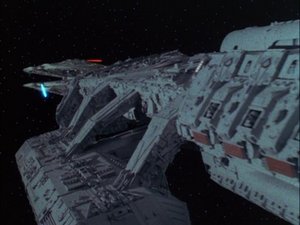(Zwischenspeicherung) |
(Zwischenspeicherung) |
||
| Zeile 90: | Zeile 90: | ||
:*The central basestar core was in fact the interior of the mockup or backup vehicle of [[w:Skylab|Skylab]], the first United States space station, which was used from 1973 to 1974. Two flight-ready Skylabs were built; the flown station reentered the atmosphere in 1979 to great international fanfare and speculation as to its crash and debris site. The second flight-ready vehicle is available for viewing at the [[w:National Air and Space Museum|National Air and Space Museum]]. The mockup resides in the hands of the [[w:United States Space & Rocket Center|United States Space & Rocket Center]] and underwent restoration. | :*The central basestar core was in fact the interior of the mockup or backup vehicle of [[w:Skylab|Skylab]], the first United States space station, which was used from 1973 to 1974. Two flight-ready Skylabs were built; the flown station reentered the atmosphere in 1979 to great international fanfare and speculation as to its crash and debris site. The second flight-ready vehicle is available for viewing at the [[w:National Air and Space Museum|National Air and Space Museum]]. The mockup resides in the hands of the [[w:United States Space & Rocket Center|United States Space & Rocket Center]] and underwent restoration. | ||
== | == Analyse == | ||
* Boomer | * Boomer spekuliert, dass das von ihnen aufgezeichnete Signal auf einer harmonischen Frequenz liegen könnte, wodurch die ursprüngliche Frequenz verdoppelt oder vervierfacht wird. Wenn es eine harmonische Frequenz ist, kommt das Signal aus der Nähe. Das Planetensystem, das sie erkundet haben, hat einen großen [[w:Jupiter|Jupiter]-ähnlichen Gasriesen, einen [[w:Venus|Venus]]-ähnlichen Planeten mit einer komprimierten Kohlendioxidatmosphäre und eine leblose rote [[w:Mars|Mars]]-ähnliche Welt. Es ist unser [[w:Sonnensystem|Sonnensystem]], aber dies wird nicht weiter untersucht, aus Angst, ein weiterer zylonischer Basisstern könnte kommen, um dies zu untersuchen. | ||
* | |||
* | * Wie aus früheren Episoden wie "[[Kampfstern Galactica (Pilotfilm)|Kampfstern Galactica]]" und "[[Zu Lebzeiten Legende, Teil I|Zu Lebzeiten Legende]]" hervorgeht, sind ein zylonischer [[Basisstern (TOS)|Basisstern]] und ein kolonialer [[Kampfstern (TOS)|Kampfstern]] ungefähr gleich stark. | ||
* | |||
* | * Diese Episode legt nahe, dass die ''Galactica''-Saga Hunderte oder sogar Tausende von Jahren in ferner Zukunft spielt. Daher wäre die Erde höchstwahrscheinlich technologisch und politisch weit genug fortgeschritten, um ihren Brüdern aus den [[Die Zwölf Kolonien (TOS)|Kolonien]] zu helfen. ''[[Galactica 1980]]'' widerspricht dem jedoch. | ||
* | |||
* Sofern ein koloniales "Jahr" nicht wesentlich kürzer als 365 Erdentage ist, erzeugt die Episode einen zeitlichen Kontinuitätsfehler zwischen der Originalserie und ihrem Spin-off ''Galactica 1980''. ''Galactica 1980'' beginnt mit der Ankunft der ''Galactica'' 1980 auf der Erde nach einer "30-jährigen" Reise. Selbst wenn die ''Galactica'' in dieser Episode die Apollo-Landung "live" aufnimmt, gibt es nur einen Unterschied von 11 Jahren zwischen 1969, als die Mondlandung stattfand, und 1980, als die ''Galactica'' es zur Erde schafft. Unter der Annahme, dass das Sternensystem, in dem die ''Galactica'' das Signal empfängt, nicht das Sol-System ist, würden die Übertragungen von der Mondlandung von 1969 (mit Lichtgeschwindigkeit) viel, viel länger dauern, um den interstellaren (wenn nicht intergalaktischen) Raum zu durchqueren, um die ''Galactica'' zu erreichen. | |||
* Ähnlich wie in der [[Battlestar Galactica (RDM)|neu-interpretierten Serie]] ist die zeitliche Einstufung der Originalserie in Bezug auf die reale Erde chronologisch mehrdeutig. Es gibt keine endgültige Möglichkeit, im Rahmen der Originalserie zu beweisen, in welchem Zeitraum die Reise der ''Galactica'' und ihrer Flotte stattfindet, nur dass es irgendwann nach 1969 ist. Nur ''Galactica 1980'' gibt eine genaue Datumsmarkierung in Bezug auf die Erde an. Dies bedeutet, dass das in dieser Episode angetroffene Sternensystem [[w:Alpha Centauri|Alpha Centauri]] sein muss, da es der einzige nahe gelegene Stern ist, der sich ausreichend nahe an unserem Sonnensystem befindet, damit das Datum 1980 funktioniert. In diesem Fall würde die ''Galactica'' die Apollo 11-Landung Ende 1973 empfangen, während sich Alpha Centauri direkt zwischen der Erde und der Kolonialflotte befindet. Von dort aus dauert die verbleibende Reise mit Unter-Lichtgeschwindigkeit zu unserem Sonnensystem 5-6 Erdjahre und die Flotte kommt 1980 an. | |||
* Theoretisch wäre die erste Videoübertragung, die die ''Galactica'' von der Erde empfangen könnte, die Ausstrahlung der Eröffnungszeremonien der [[w:Olympische Sommerspiele 1936|Olympischen Sommerspiele 1936]] aus Berlin. Zu diesem Zeitpunkt hätte die ''Galactica'' jedoch auch viele Jahre lang Funksignale empfangen. Jemand müsste jedoch diese Signalen überwachen, welche bestimmt als überflüssigen und "alten" angesehen worden wären. Dies ist vergleichbar mit der SETI-Überwachung von Funkübertragungen. Ohne Personen und finanzielle Mittel überwacht niemand diese Daten. | |||
== Fragen == | == Fragen == | ||
Version vom 22. Mai 2021, 12:54 Uhr

| ||
| "Die große Schlacht" Eine Episode der Originalserie | ||
|---|---|---|
| Episoden-Nr. | Staffel TOS, Episode 24 | |
| Originaltitel | The Hand of God | |
| Autor(en) | Donald Bellisario | |
| Story | ||
| Regie | Donald Bellisario | |
| Gastauftritte | ||
| Produktions-Nr. | 50930 | |
| Quoten | ||
| US-Erstausstrahlung | ||
| UK-Erstausstrahlung | ||
| DE-Erstausstrahlung | ||
| DVD-Veröffentlichung | 2004-12-28 | |
| Bevölkerung | Überlebende | |
| Zusätzliche Info | Serien Finale | |
| Episoden-Chronologie | ||
| Vorige | ||
| Die Meuterei | Die große Schlacht | |
- Commander Adama beschließt, nicht mehr vor den Zylonen zu fliehen, und startet einen umfassenden Angriff auf einen Basisstern.
Zusammenfassung
Der restliche Text muss noch übersetzt werden. Der englische Text befindet sich unter "bearbeiten".